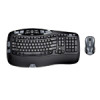Logitech Desktop Wave Role of Comfort in Product Design
Logitech Desktop Wave Manual
 |
View all Logitech Desktop Wave manuals
Add to My Manuals
Save this manual to your list of manuals |
Logitech Desktop Wave manual content summary:
- Logitech Desktop Wave | Role of Comfort in Product Design - Page 1
, Irreplaceable Quality that Links These Products with the New Logitech Comfort Wave Keyboard We put up with discomfort when we don't have an seat that stretched from driver to passenger and a thin, curved beam that hit the upper back, providing minimal support. Though many later iterations - Logitech Desktop Wave | Role of Comfort in Product Design - Page 2
people had to balance on when driving. Logitech's Definition of the Role of Comfort in back John Fliss supports, headrests and heated remember up to three different car-seat settings, automatically adjusting to a preset position We tell ourselves that the keyboard should have a certain shape - Logitech Desktop Wave | Role of Comfort in Product Design - Page 3
the bag improved on the earlier rucksack - and supported more weight by distributing the load to the to Seattle, he purchased an industrial sewing machine and after more than eight years of trial and within a year, the U.S. Forest Service wanted 1,000 TragerUSA Trager external frame backpack. - Logitech Desktop Wave | Role of Comfort in Product Design - Page 4
Comfort is a source of support, both physically and emotionally; began creating models to test the motions - twisting, turning, pushing, Logitech's keyboard development team to create the Comfort Wave Design. Recognizing that fingers aren't all the same length, the team created a wave-shaped keyboard

www.3-wheelers.com
1885 Benz Motorwagen with bench seat.
The Role of Comfort in Product Design
The Evolution of the Car Seat, the Backpack and the Vegetable Peeler
The Irresistible, Irreplaceable Quality that Links These Products with the
New Logitech Comfort Wave Keyboard
We put up with discomfort when we don’t have an alternative. We put up with it until something
better appears. And once in a while something new comes along that makes such a strong
impact that we come to depend on it, to expect it to provide comfort, to feel that we deserve it. We
know a product’s redesign is successful when we find ourselves unable to believe that we ever
used the previous version, or, better still, forget that the old design ever existed at all.
If comfort is something we all value once we have it, why do we put up with so much discomfort in
our everyday lives? We sit in old, worn seats at the movie theater, our bodies sore from sitting in
the same position for an extended amount of time. We type on our keyboards and stare at our
computer screens for hours at a time. And, as the hours go by, we slouch, our vision blurs, and
our necks and backs begin to ache.
Fortunately, some products – such as the car seat, the backpack, the vegetable peeler and, with
the introduction of the Logitech Comfort Wave Design, the computer keyboard – capture the
attention of individuals or companies dedicated to making them more comfortable, more in line
with the human form. When those individuals or companies are successful, the design shift sets a
new standard for comfort that we wouldn’t want to live without.
The Car Seat: Comforting the Weary Commuter
In every city of the world, we see them: the weary commuter. Maybe you’re among them.
The American Association of State Highway and Transportation estimates that in 2005, traffic
congestion kept Americans sitting for 79 million additional hours in their cars. In Los Angeles,
rush-hour traffic delays added 93 hours to the commute.
According to Edmund King, the executive director of the RAC Foundation for Motoring, England is
a nation of car commuters. “We have the longest commute in Europe,” King told the BBC, “and
even if our commuting time doubled most of us would just shrug and leave more time for the
journey.”
The New Yorker magazine states that people working in Bangkok travel two hours every day to
and from work. And, BusinessWeek reports that traffic jams in the Indian city of Bangalore can
cause up to four-hour commutes!
Fortunately, car-seat design has improved
tremendously. It wasn’t always so comfortable
and the evolution from bench seat to bucket
seat is a story of gradual evolution.
Karl Benz’s 1885 Motorwagen had a hard, wood
bench seat that stretched from driver to
passenger and a thin, curved beam that hit the
upper back, providing minimal support. Though
many later iterations of the bench seat had
padded upholstery and more substantial back
support, these bench seats were often fixed in
one position. If you couldn’t reach the pedals or
the wheel, you had to perch on the edge of the
seat.






